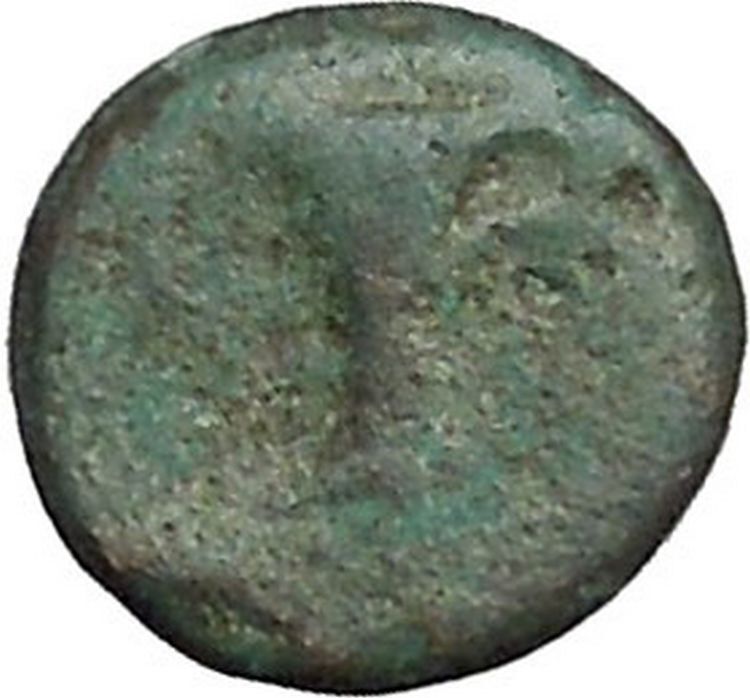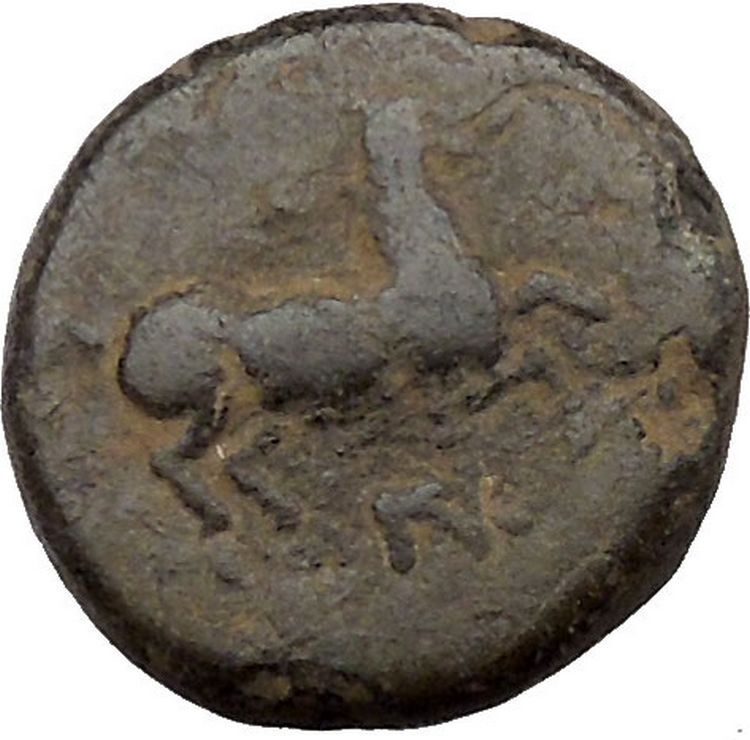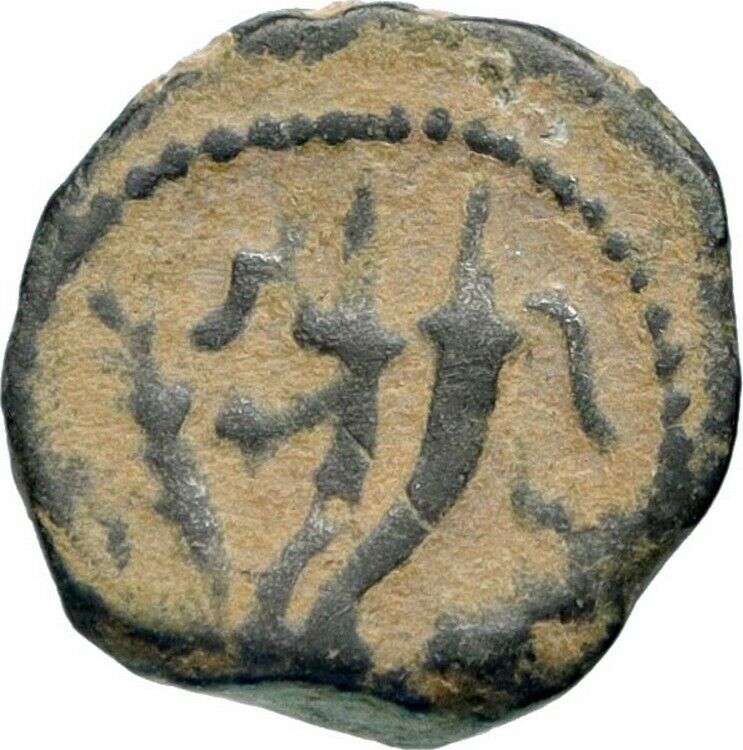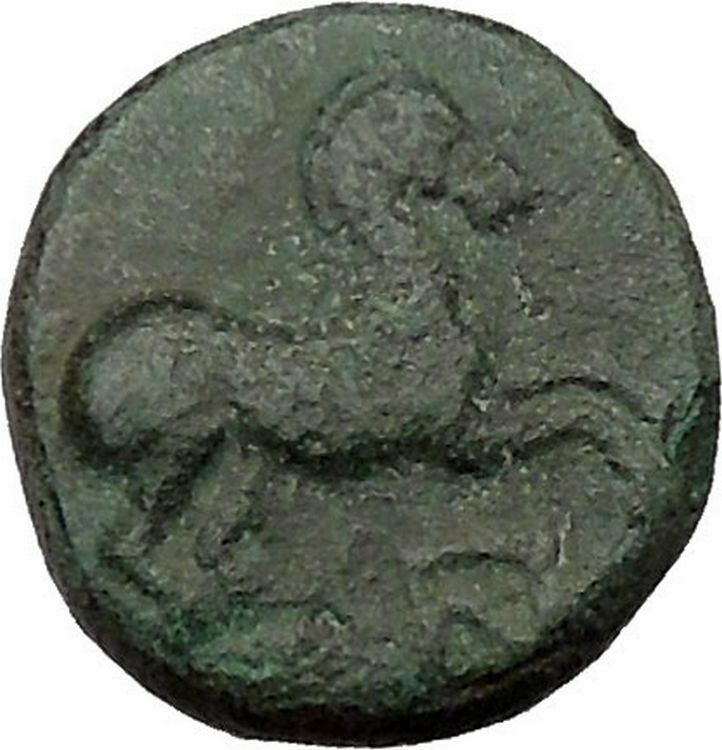|
Greek city of Kabeira in Pontus
Bronze 20mm (6.99 grams) Struck under Mithradates VI the Great circa 111-105 B.C. or circa 95-90 B.C.
Reference: HGC 7, 271 Rare R2
Head of young Ares right, wearing crested Attic helmet.
Sword in sheath; KABH – PΩN across field.
Situated in the valley of the Lykos, Kabeira was a favorite residence of Mithradates, and it was in the vicinity of this place that the Pontic King was defeated by Lucullus in 71 B.C.
You are bidding on the exact item pictured, provided with a Certificate of Authenticity and Lifetime Guarantee of Authenticity.
 Ares is the Greek god of war. He is one of the Twelve Olympians, and the son of Zeus and Hera. In Greek literature, he often represents the physical or violent aspect of war, in contrast to the armored Athena, whose functions as a goddess of intelligence include military strategy and generalship. Ares is the Greek god of war. He is one of the Twelve Olympians, and the son of Zeus and Hera. In Greek literature, he often represents the physical or violent aspect of war, in contrast to the armored Athena, whose functions as a goddess of intelligence include military strategy and generalship.
The Greeks were ambivalent toward Ares: although he embodied the physical valor necessary for success in war, he was a dangerous force, “overwhelming, insatiable in battle, destructive, and man-slaughtering.” Fear (Phobos) and Terror (Deimos) were yoked to his battle chariot. In the Iliad his father Zeus tells him that he is the god most hateful to him. An association with Ares endows places and objects with a savage, dangerous, or militarized quality. His value as a war god is even placed in doubt: during the Trojan War, Ares was on the losing side, while Athena, often depicted in Greek art as holding Nike (Victory) in her hand, favored the triumphant Greeks.
Ares plays a relatively limited role in Greek mythology as represented in literary narratives, though his numerous love affairs and abundant offspring are often alluded to. When Ares does appear in myths, he typically faces humiliation. He is well known as the lover of Aphrodite, the goddess of love who was married to Hephaestus, god of craftsmanship, but the most famous story involving the couple shows them exposed to ridicule through the wronged husband’s clever device.
The counterpart of Ares among the Roman gods is Mars, who as a father of the Roman people held a more important and dignified place in ancient Roman religion for his agricultural and tutelary functions. During the Hellenization of Latin literature, the myths of Ares were reinterpreted by Roman writers under the name of Mars. Greek writers under Roman rule also recorded cult practices and beliefs pertaining to Mars under the name of Ares. Thus in the classical tradition of later Western art and literature, the mythology of the two figures becomes virtually indistinguishable.

Mithridates VI or Mithradates VI (Greek: Μιθραδάτης), from Old Persian Mithradatha, “gift of Mithra”; 134-63 BC, also known as Mithradates the Great (Megas) and Eupator Dionysius, was king of Pontus and Armenia Minor in northern Anatolia (now Turkey) from about 120-63 BC. Mithridates is remembered as one of the Roman Republic’s most formidable and successful enemies, who engaged three of the prominent generals from the late Roman Republic in the Mithridatic Wars: Lucius Cornelius Sulla, Lucullus and Pompey. He was also the greatest ruler of the Kingdom of Pontus.
Cabira, a place in Pontus, at the base of the range of Paryadres, about 150 stadia south of Eupatoria or Magnopolis, which was at the junction of the Iris and the Lycus. Eupatoria was in the midst of the plain, but Cabira, as Strabo says (p. 556), was at the base of the Paryadres. Mithridates the Great built a palace at Cabira; and there was a water-mill there (Greek: ὑδραλέτης), and places for keeping wild animals, hunting grounds, and mines. Less than 200 stadia from Cabira was the remarkable rock or fortress called Caenon (Greek: Καινόν), where Mithridates kept his most valuable things. Cn. Pompeius took the place and its treasures, which, when Strabo wrote, were in the Roman Capitol. In Strabo’s time a woman, Pythodoris, the widow of King Polemo, had Cabira with the Zelitis and Magnopolitis. Pompeius made Cabira a city, and gave it the name Diopolis. Pythodoris enlarged it, and gave it the name Sebaste, which is equivalent to Augusta; and she used it as her royal residence. Near Cabira probably (for the text of Strabo is a little uncertain, and not quite clear; Groskurd, transl. vol. ii. p. 491, note) at a village named Ameria, there was a temple with a great number of slaves belonging to it, and the high priest enjoyed this benefice. The god Men Pharnaces was worshipped at Cabira. Mithridates was at Cabira during the winter that L. Lucullus was besieging Amisus and Eupatoria. (Appian, Mithrid. c. 78.) Lucullus afterwards took Cabira. (Plutarch, Lucullus, c. 18.) There are some autonomous coins of Cabira with the epigraph “Καβηρων”.
Strabo, a native of Amasia, could not be unacquainted with the site of Cabira. The only place that corresponds to his description is Niksar, on the right bank of the Lycus, nearly 43 km from the junction of the Iris and the Lycus. But Niksar is the representative of Neocaesarea, a name which first occurs in Pliny (vi. 3), who says that it is on the Lycus. There is no trace of any ancient city between Niksar and the junction of the two rivers, and the conclusion that Niksar is a later name of Cabira, and a name more recent than Sebaste, seems certain. (Hamilton’s Researches, &c. vol. i. p. 346.) Pliny, indeed, mentions both Sebastia and Sebastopolis in Colopena, a district of Cappadocia, but nothing certain can be inferred from this. Neocaesarea seems to have arisen under the early Roman emperors. Cramer (Asia Minor, vol. i. p. 315) states that the earliest coins of Neocaesarea bear the effigy of Tiberius; but Sestini, quoted by Forbiger (Geog. vol. ii. p. 428), assigns the origin of Neocaesarea to the time of Nero, about 64 CE, when Pontus Polemoniacus was made a Roman province. The simplest solution of this question is that Neocaesarea was a new town, which might be near the site of Cabira. It was the capital of Pontus Polemoniacus, the birthplace of Gregorius Thaumaturgus, and the place of assembly of a church council in 314. Ammianus Marcellinus (xxvii. 12) calls it the most noted city of Pontus Polemoniacus: it was, in fact, the metropolis. According to Paulus Diaconus the place was destroyed by an earthquake.
Cramer supposes that Neocaesarea is identical with Ameria, and he adds that Neocaesarea was the principal seat of pagan idolatry and superstitions, which affords another presumption that it had risen on the foundation of Ameria and the worship of Men Pharnaces. But Ameria seems to have been at or near Cabira; and all difficulties are reconciled by supposing that Cabira, Ameria, Neocaesarea [p. 463] were in the valley of the Lycus, and if not on the same spot, at least very near to one another. Stephanus of Byzantium (s. v. Νεοκαισάρεια: Eth. Νεοκαισαριεύς) adds to our difficulties by saying or seeming to say that the inhabitants were also called Adrianopolitae, suggesting the city’s name was Adrianopolis or Hadrianopolis. Where he got this from, nobody can tell.
Hamilton was informed at Niksar that on the road from Niksar to Sivas, and about fourteen hours from Niksar, there is a high perpendicular rock, almost inaccessible on all sides, with a stream of water flowing from the top, and a river at its base. This is exactly Strabo’s description of Caenon.
|





 Ares is the Greek god of war. He is one of the Twelve Olympians, and the son of Zeus and Hera. In Greek literature, he often represents the physical or violent aspect of war, in contrast to the armored Athena, whose functions as a goddess of intelligence include military strategy and generalship.
Ares is the Greek god of war. He is one of the Twelve Olympians, and the son of Zeus and Hera. In Greek literature, he often represents the physical or violent aspect of war, in contrast to the armored Athena, whose functions as a goddess of intelligence include military strategy and generalship.





